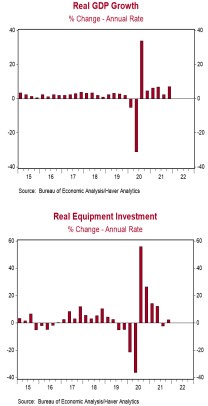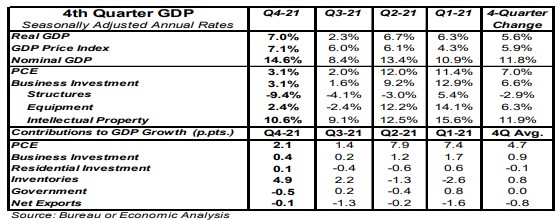- Real GDP growth in Q4 was revised up to a 7.0% annual rate from a prior estimate of 6.9%, matching consensus expectations.
- Slight upward revisions to business investment, home building, and government purchases more than offset downward revisions to consumer spending and net exports.
- The largest positive contributions to the real GDP growth rate in Q4 were inventories and consumer spending. The weakest component was government purchases.
- The GDP price index was revised up to a 7.1% annual growth rate from a prior estimate of 6.9%. Nominal GDP growth – real GDP plus inflation – was revised up to a 14.6% annual rate from a prior estimate of 14.3%.
Implications:
Today’s second report on Q4 real GDP was revised slightly higher from the initial reading a month ago, growing at a 7.0% annual rate. As a result, real GDP was up 5.6% in 2021 (Q4/Q4), the fastest growth for any calendar year since the Reagan Boom in 1984. The slight upward revision to the overall number in Q4 was due to small revisions in a number of GDP categories, led by business investment, government purchases, and residential investment. Most of the growth in Q4 itself was due to a much faster pace of inventory accumulation, which will not be repeated in 2022. And in spite of rapid growth in 2021, real GDP finished the year only up at a 1.6% annual rate since the end of 2019, which is slower than the pre-COVID trend. In other words, the US economy is still smaller than it would have been if COVID and the related lockdowns had never happened. Unlike the Reagan Boom or other periods of robust economic growth, the growth in 2021 was artificially boosted by massive government spending and a recovery from the most draconian period of COVID restrictions in 2020. But do you know what’s clearly higher than the pre-COVID trend? Inflation. GDP prices were revised higher, rising at a 7.1% annual rate in Q4 and prices rose 5.9% in 2021 (Q4/Q4), the largest gain for any calendar year since 1981. GDP prices are up 3.6% annualized since right before COVID hit, which, unlike real GDP, is clearly above trend. Combining real GDP growth and inflation gives us nominal GDP, which is up at a 5.2% annual rate since right before COVID, very close to the pre-COVID trend. This year will be marked by transitions for the US economy, including slower economic growth, less upward pressure on (but still stubbornly high) inflation, and a liftoff for short-term interest rates. Look for real GDP growth of around 2.5% in 2022 while GDP prices rise around 5.0%. Why slower economic growth? Because massive government spending in 2020-21 artificially covered up economic pain like an opioid given to a crash victim. But more doses of opioids are becoming less likely, meaning growth is heading back toward a more normal level. In other news this morning, initial unemployment claims declined 17,000 last week to 232,000. Continuing claims declined 112,000 to 1.476 million, the lowest in more than fifty years. These figures are consistent with strong job growth in February.





